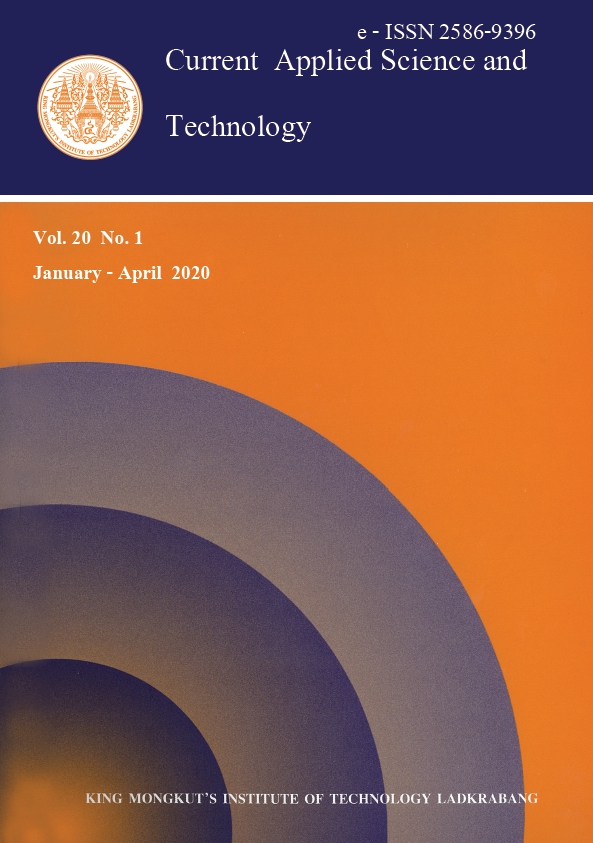Effect of Surface Treatment on Electrical Properties of Polydimethylsiloxane Based Triboelectric Nanogenerator
Main Article Content
Abstract
This research investigated the effect of surface treatment on electrical properties of flexible triboelectric nanogenerator (TENG). Polydimethylsiloxane (PDMS) was used as triboelectric layer. The PDMS pads were prepared by simple casting method and the effect of surface treatments by heat and acid was examined. Physical morphology of treated samples were investigated by scanning electron microscope (SEM). Electrical properties were measured under continuous periodic knocking. The results revealed that the heat-treated PDMS-based TENG showed the outstanding output voltage. The maximum output voltage of heat-treated based TENG reached approximately 9 V, which was over 4 times larger than those of normal PDMS based TENG. The research demonstrated the feasibility to utilize PDMS-based TENG as an energy harvesting device and presented a cost-effective method for producing high-efficiency PDMS based TENG.
Keywords: triboelectric; surface treatment; polydimethylsiloxane; nanogenerator
*Corresponding author: Tel.: +66 84-669-4115
E-mail: c.nawanil@gmail.com
Article Details
Copyright Transfer Statement
The copyright of this article is transferred to Current Applied Science and Technology journal with effect if and when the article is accepted for publication. The copyright transfer covers the exclusive right to reproduce and distribute the article, including reprints, translations, photographic reproductions, electronic form (offline, online) or any other reproductions of similar nature.
The author warrants that this contribution is original and that he/she has full power to make this grant. The author signs for and accepts responsibility for releasing this material on behalf of any and all co-authors.
Here is the link for download: Copyright transfer form.pdf
References
Cheng, X., Song, Y., Han, M., Meng, B., Su, Z., Miao, L. and Zhang, H., 2016. A flexible large-area triboelectric generator by low-cost roll-to-roll process for location-based monitoring. Sensors and Actuators A, 247, 206-214.
Khan, A.A., Mahmud, A., Zhang, S., Islam, S., Voss, P. and Ban, D., 2019. A self-powered multi-broadcasting wireless sensing system realized with an all-in-one triboelectric nanogenerator. Nano Energy, DOI: 10.1016/j.nanoen.2019.05.073.
Xing, F., Jie, Y., Cao, X., Li, T. and Wang, N., 2017. Natural triboelectric nanogenerator based on soles for harvesting low frequency walking energy. Nano Energy, 42, 138–142.
Tian, Z., He, J., Chen, X., Zhang, Z., Wen, T., Zhai, C., Han, J., Mu, J., Hou, X., Chou., X and Xue, C., 2017. Performance-boosted triboelectric textile for harvesting human motion energy. Nano Energy, 39, 562-570.
Wang, X., Yin, Y., Yi, F., Dai, K., Niu, S., Han, Y., Zhang, Y. and You, Z., 2017. Bioinspired stretchable triboelectric nanogenerator as energy-harvesting skin for self-powered electronics. Nano Energy, 39, 429-436.
Xiang, C., Liu, C., Hao, C., Wang, Z., Chea, L. and Zhou, X., 2017. A self-powered acceleration sensor with flexible materials based on triboelectric effect. Nano Energy, 31, 469-477.
Wang, Z.L., Chen, J. and Lin, L., 2015. Progress in triboelectric nanogenerators as a new energy technology and self-powered sensors. Energy and Environmental Science, 8(8), 2250-2282.
Rasel, M.S., Cho, H.O., Kim, J.W. and Park, J.Y., 2018. A self-powered triboelectric sensor for wide-range pressure detection in wearable application. Journal of Physics: Conference Series, 1052, 012029.
Zhu, D., Handschuh-Wang, S. and Zhou, X., 2017. Recent progress in fabrication and application of polydimethylsiloxane Sponges. Journal of Materials Chemistry A, 5(32), 16467-16497.
Chen, J., Guo, H., He, X., Liu, G., Xi, Y., Shi, G. and Hu, C., 2016. Enhancing performance of triboelectric nanogenerator by filling high dielectric nanoparticles into sponge PDMS film. ACS Applied Materials and Interfaces, 8(1), 736-744.
Yun, B.K., Kim, J.W., Kim, H.S., Jung, K.W., Yi, Y., Jeong, M.S., Ko, J.H. and Jung, J.H., 2015. Base-treated polydimethylsiloxane surfaces as enhanced triboelectric nanogenerators, Nano Energy, 15, 523-529.
Park, S.J., Seol, M.L., Jeon, S.B., Kim, D., Lee, D. and Choi, Y.K., 2015. Surface engineering of triboelectric nanogenerator with an electrodeposited gold nanoflower structure. Scientific Reports, 5(1), 1-7. doi: 10.1038/srep13866.
Guo, T., Liu, G., Pang, Y., Wu, B., Xi, F., Zhao, J., Bu, T., Fu, X., Li, X., Zhang, C. and Wang, Z.L., 2018. Compressible hexagonal-structured triboelectric nanogenerators for harvesting tire rotation energy. Extreme Mechanics Letters, 18, 1-8.
Dong, Y., Mallineni, S.S.K., Maleski, K., Behlow, H., Mochalin, V.N., Rao, A.M., Gogotsi, Y. and Podila, R., 2018. Metallic MXenes: A new family of materials for flexible triboelectric Nanogenerators. Nano Energy, 44, 103-110.
Yu, Y. and Wang, X., 2016. Chemical modification of polymer surfaces for advanced triboelectric nanogenerator development. Extreme Mechanics Letters, 9, 514-530.
Nour, M., Berean, K., Balendhran, S., Ou, J.Z., Plessis, J.D., McSweeney, C., Bhaskaran, M., Sriram, S. and Kalantar-zadeh, K., 2013. CNT/PDMS composite membranes for H2 and CH4 gas separation. International Journal of Hydrogen Energy, 38(25), 10494-10501.
Kuo, A.C.M., 1999. Poly(dimethylsiloxane). In: J.E. Mark, ed. 1999. Polymer Data Handbook. Oxford University Press Inc, New York, pp. 411-435.
Shao, L., Tobias, G., Salzmann, C.G., Ballesteros, B. and Hong, S.Y., Crossley, A., Davis, B.G. and Green, M.L.H., 2007. Removal of amorphous carbon for the efficient sidewall functionalisation of single-walled carbon nanotubes. Chemical Communications, 47, 5090-5092.
Pan, S. and Zhang, Z., 2018. Fundamental theories and basic principles of triboelectric effect: A review. Friction, 7(1), 2-17.


